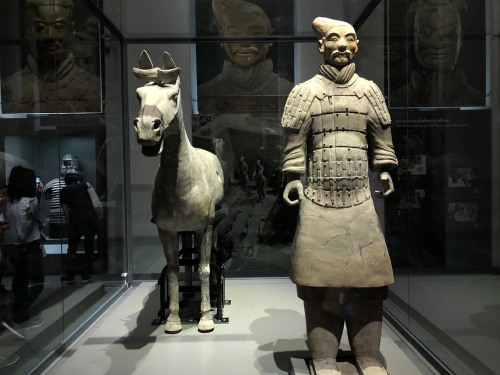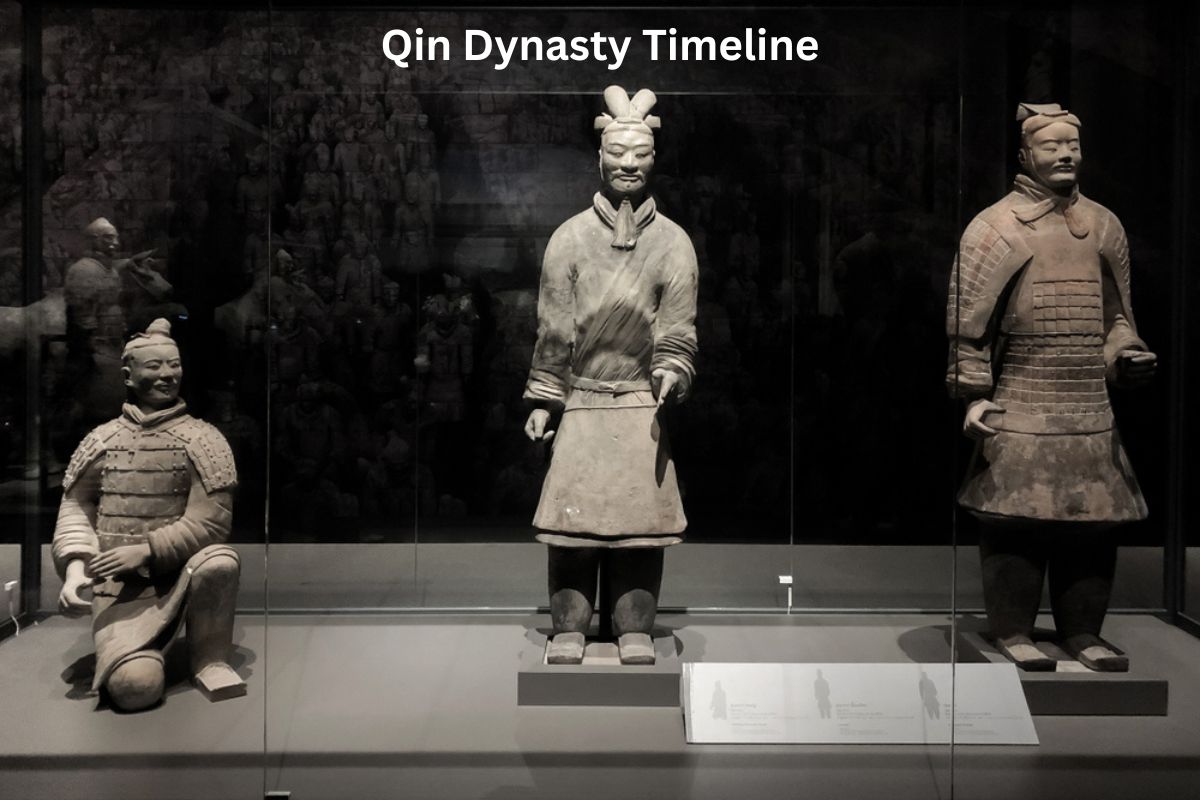The Qin Dynasty, pronounced as “chin”, was the first imperial dynasty of China, lasting from 221 to 206 BC. It followed the Warring States period, during which the territory of China was divided among seven major states.
The Qin state, under the leadership of Ying Zheng, who later declared himself Qin Shi Huang or “First Emperor of Qin”, succeeded in unifying these states.
Despite its relatively short duration, the Qin Dynasty had a profound impact on China. It’s renowned for its military conquests, centralization of power, standardization of laws, currencies, weights, measures, and the Chinese script, which greatly unified the Chinese culture and language.
Also Read: Qin Dynasty Accomplishments
The construction of the Great Wall also began during this time. However, the dynasty is also remembered for its oppressive rule, leading to widespread rebellions, and culminating in the rise of the Han Dynasty.
| Year | Event |
|---|---|
| 770 BC | The Zhou dynasty creates the feudal state of Qin. |
| 356 BC | Ying Zheng, who would later become Qin Shi Huang, is born. |
| 338 BC | King Huiwen of Qin ascends to the throne and begins to make reforms to strengthen the state of Qin. |
| 325 BC | King Huiwen of Qin standardizes weight and measure. |
| 247 BC | Ying Zheng ascends the throne of Qin at the age of nine. |
| 238 BC | Ying Zheng assumes full personal rule of the kingdom after surviving an assassination attempt. |
| 230-221 BC | Qin state conquers the other six major states (Han, Zhao, Wei, Chu, Yan, Qi). |
| 221 BC | Ying Zheng declares himself “Qin Shi Huang” or “First Emperor of Qin”. |
| 221-210 BC | Qin Shi Huang implements a series of reforms. |
| 213 BC | The “Burning of Books and Burying of Scholars” incident occurs. |
| 210 BC | Qin Shi Huang dies. His son, Huhai, becomes the Second Emperor, Qin Er Shi. |
| 209 BC | Rebellion against the Qin Dynasty begins, known as the Dazexiang Uprising. |
| 207 BC | Liu Bang, a rebel leader, proclaims himself King of Han. |
| 206 BC | Qin Er Shi is killed, marking the end of the Qin Dynasty. Liu Bang establishes the Han Dynasty. |
Timeline of the Qin Dynasty
770 BC – The Zhou dynasty creates the feudal state of Qin
The Zhou Dynasty, one of the longest-lasting dynasties in Chinese history, divided the land into feudal states. The state of Qin was one of them.
Also Read: Han Dynasty Facts
This allowed Qin to grow and eventually develop into a powerful state capable of uniting all of China.
356 BC – Ying Zheng, who would later become Qin Shi Huang, is born
Ying Zheng was born to King Zhuangxiang of Qin and Queen Zhao Ji. The circumstances of his birth are historically debated due to multiple accounts, some of which suggest intrigue and scandal. Regardless, he was the heir apparent to the throne of Qin.

338 BC – King Huiwen of Qin ascends to the throne and begins to make reforms to strengthen the state of Qin
King Huiwen of Qin ruled from 338 to 311 BC and implemented a number of significant reforms. He abolished the old feudal nobility and replaced them with a bureaucracy filled by officials selected for their merit. He also established a uniform legal code, helping to unify and strengthen the state.
325 BC – King Huiwen of Qin standardizes weight and measure
This was one of the significant administrative reforms made during King Huiwen’s reign. Standardizing weights and measures across the kingdom meant that trade, taxation, and construction could be conducted more fairly and efficiently. It was a crucial step in the centralization of the state.
247 BC – Ying Zheng ascends the throne of Qin at the age of nine
Ying Zheng came to power after the death of his father, King Zhuangxiang of Qin. Since he was only a child, the early years of his reign were guided by a regent, Lu Buwei.
238 BC – Ying Zheng assumes full personal rule of the kingdom after surviving an assassination attempt
An attempted assassination led by the chancellor Lu Buwei (who was also suspected to be involved in a scandal with the queen dowager) marked the end of the regency.
After surviving the assassination attempt, Ying Zheng took direct control of the kingdom, exerting his own power and beginning his plan to unify all of China.

230-221 BC – Qin state conquers the other six major states (Han, Zhao, Wei, Chu, Yan, Qi)
This period marked the end of the Warring States period and the beginning of a unified China. Ying Zheng led a series of military campaigns against the other six major states, successfully conquering them all. By 221 BC, he had unified all of the Chinese states under his rule.
221 BC – Ying Zheng declares himself “Qin Shi Huang” or “First Emperor of Qin”
After the unification of China, Ying Zheng took the title “Qin Shi Huang”, which means “First Emperor of Qin”. This title was significant because it implied that his successors would continue his dynasty, marking the beginning of imperial China. He declared the start of the Qin Dynasty and embarked on a series of centralizing reforms.
221-210 BC – Qin Shi Huang implements a series of reforms
These reforms aimed to unify and centralize the empire. He standardized the writing system, weights and measures, and even the length of cart axles to make roads more uniform. He also initiated the construction of a series of fortifications, which would later become part of the Great Wall of China.
Additionally, he formed a central bureaucracy, taking power away from the old feudal nobility. His rule, despite being seen as autocratic and brutal, laid the foundation for future Chinese dynasties.
213 BC – The “Burning of Books and Burying of Scholars” incident occurs
This event is one of the most notorious acts of censorship in history. Seeking to centralize power and suppress intellectual dissent, Qin Shi Huang ordered the burning of many books, particularly those on philosophy, history, and literature from other states.
Additionally, some accounts indicate that hundreds of scholars were buried alive, although these accounts might be exaggerated. Despite the controversy surrounding this event, it shows how Qin Shi Huang prioritized political unity over intellectual diversity.
210 BC – Qin Shi Huang dies. His son, Huhai, becomes the Second Emperor, Qin Er Shi
Qin Shi Huang died while on a journey to find the elixir of immortality. His death was kept a secret until his entourage returned to the capital. He was buried in a grand tomb guarded by the now-famous Terracotta Army.
His son, Huhai, who was the eighteenth son of Qin Shi Huang, became the Second Emperor, Qin Er Shi, after a power struggle.
209 BC – Rebellion against the Qin Dynasty begins, known as the Dazexiang Uprising
The Qin Dynasty was severe and oppressive, leading to discontent among the people. The Dazexiang Uprising, led by Chen Sheng and Wu Guang, was one of the first rebellions against the Qin rule. Although this particular rebellion was crushed, it inspired numerous other uprisings across the country.
207 BC – Liu Bang, a rebel leader, proclaims himself King of Han
Liu Bang was a minor official with a humble background who rose to prominence during the uprisings. In 207 BC, he proclaimed himself King of Han, and his forces continued to fight against the Qin Dynasty, gaining more and more territory.
206 BC – Qin Er Shi is killed, marking the end of the Qin Dynasty. Liu Bang establishes the Han Dynasty
Faced with widespread rebellions, the Qin Dynasty couldn’t hold onto power. Qin Er Shi was killed in a palace coup, marking the end of the Qin Dynasty. After several more years of conflict known as the Chu-Han Contention, Liu Bang emerged victorious, founding the Han Dynasty, which would become one of the longest and most influential dynasties in Chinese history.
